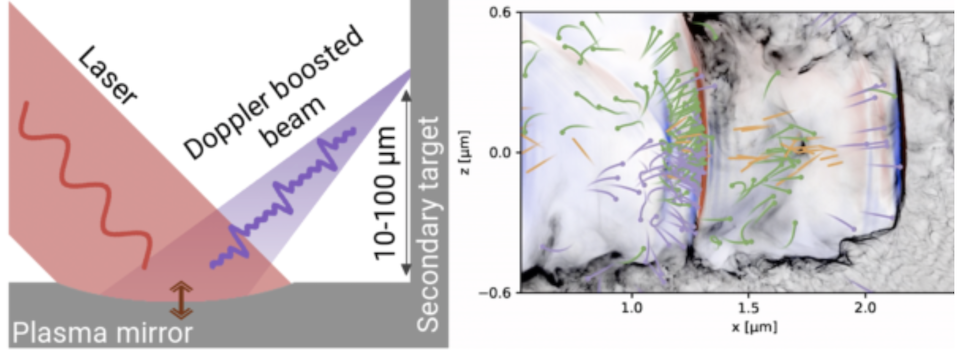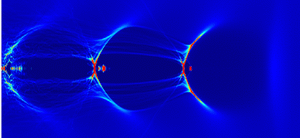— Berkeley Lab’s researchers, unique capabilities aided international effort to probe fundamental questions in physics
Cracking Open Strong-Field Quantum Electrodynamics
“A powerful demonstration of how advanced simulation of complex systems can enable new paths for discovery.”
— ATAP Division Director Cameron Geddes
A newly published theoretical and computer modeling study, which relied upon the WarpX code, suggests that the world’s most powerful lasers might finally crack the elusive physics behind some of the most extreme phenomena in the universe — gamma ray bursts, pulsar magnetospheres, and more. The international team behind the study includes researchers from Lawrence Berkeley National Laboratory (Berkeley Lab) and France’s Alternative Energies and Atomic Energy Commission (CEA-LIDYL). They report their findings in a 10 September 2021 Physical Review Letter. Learn more…

Left: In the proposed scheme for probing SF-QED with present-day or near-future lasers, a plasma mirror shaped by radiation pressure converts an intense laser pulse (red) into Doppler-boosted harmonics (purple) and focuses them on a secondary target, reaching extreme intensities. The dimensions involved are tens to hundreds of microns (millionths of a meter); the diameter of a human hair is a few to several tens of microns. (Credit: Luca Fedeli/CEA)
Right: Berkeley Lab’s key contribution was leading the development of the simulation code used for the research. In this simulation image, the intense Doppler-boosted light pulses (red and blue) plow through the solid target (gray), generating high-energy photons (orange) that decay into pairs of electrons (green) and positrons (purple) after further interaction with the incoming light pulses. The electrons and positrons are separated due to the strong laser field. Only photons that have not yet decayed into pairs are shown. (Credit: Luca Fedeli/CEA)
Exascale Accelerator Modeling Among Highlights Featured in APS-DPB Annual Newsletter
 Each year the newsletter of the American Physical Society’s Division of Physics of Beams (APS-DPB) publishes articles about some of the most important and timely topics in accelerators and beams, written by leaders in the field. This year’s issue was edited by Alysson Gold and Nihan Sipahi, Early Career Members-at-Large of the APS-DPB Executive Committee. It features three articles directly related to ATAP’s work, including one on modeling and simulation.
Each year the newsletter of the American Physical Society’s Division of Physics of Beams (APS-DPB) publishes articles about some of the most important and timely topics in accelerators and beams, written by leaders in the field. This year’s issue was edited by Alysson Gold and Nihan Sipahi, Early Career Members-at-Large of the APS-DPB Executive Committee. It features three articles directly related to ATAP’s work, including one on modeling and simulation.
“Modeling Future Accelerators on the Eve of Exascale Computing” (pp. 16-17), by Jean-Luc Vay, head of ATAP’s Accelerator Modeling Program, describes the prospects for powerful, high-fidelity tools for the design, optimization, and perhaps even predictive control of particle accelerators. A rendering from a plasma accelerator simulation, using the Berkeley Lab Accelerator Simulation Toolkit code WARP3D, was chosen as the cover illustration for the report.
These are just a few of the 15 articles about exciting technical topics in our field. Click here for the Newsletter.
Taking Accelerator Simulations to the Exascale
The Department of Energy’s Exascale Computing Project (ECP) has announced support for 15 critical research applications for next-generation supercomputers, and LBNL’s Accelerator Technology and Applied Physics Division will lead one of them: “Exascale Modeling of Advanced Particle Accelerators,” headed by Dr. Jean-Luc Vay.
See also “The Incredible Shrinking Particle Accelerator,” an article by Kathy Kincade of the National Energy Research Supercomputing Center, which puts accelerator simulation in the context of other computational research, supercomputing, and visualization capabilities at LBNL.
BELLA Simulation Team Receives NERSC HPC Award
 |
Computer simulation of the plasma wakefield as it evolves over the length of the 9 cm long channel in BELLA. For more details on the simulation aspects, see this news release from NERSC. |
The open-category award for High Impact Scientific Achievement went to the Berkeley Lab Laser Accelerator (BELLA) Center for its use of NERSC supercomputers for the modeling of laser plasma accelerators, and in particular for the importance of modeling in the successful acceleration of electrons to 4.25 GeV in only 9 cm.
Extensive simulations using INF&RNO — a code developed under Benedetti’s leadership for modeling laser-plasma interactions and later incorporated into the Berkeley Lab Accelerator Simulation Toolkit (BLAST) and thus CAMPA — showed that the experiment and causes of fluctuations in beam energy and charge are well understood. These fully self-consistent, multi-dimensional particle-in-cell (PIC) simulations ran on the Cray XC30 supercomputer “Edison” at NERSC. They were of fundamental importance in modeling the propagation of a high-intensity laser in the plasma, characterizing the nonlinear wakefield excitation, and studying the details of particle self-trapping. The results were important in planning the experiment and also in helping us understand the results.
 |
ATAP physicist and simulation-code developer Carlo Benedetti (center) accepts a NERSC HPC Achievement Award on behalf of the BELLA Center team. Other winners included Taylor Barnes of Caltech (bottom) and Ken Chen, UC-Santa Cruz (top), as well as LBNL’s Craig Tull, SPOT Suite project (not pictured). The award ceremony took place February 24, 2015 at LBNL as part of the annual NERSC User Group meeting. To Learn More: |
NERSC HPC Achievement Award Goes To Jean-Luc Vay
LBNL’s Jean-Luc Vay was also one of the three 2014 recipients of the NERSC HPC Achievement Award. The award recognizes National Energy Research Supercomputing Center users who have demonstrated an innovative use of high-performance computing resources to solve a scientific problem, or whose work has had an exceptional impact on scientific understanding or society. Vay’s award recognized novel methods developed for and realized in the BLAST code Warp.
Jean-Luc Vay Receives US Particle Accelerator School Prize
Jean-Luc Vay was honored in 2013 with the US Particle Accelerator School Prize for Achievement in Accelerator Physics and Technology. The USPAS Prize, given every other year, recognizes the achievements of two people in the accelerator field, one of them under 45 years of age. Vay shared the award with former LBNL senior scientist Kwang-Je Kim, who is now with Argonne National Laboratory.
The award was formally presented in October at NA-PAC’13, the North American Particle Accelerator Conference. Here are links to learn more about one of Vay’s prominent achievements, the Lorentz boosted frame technique, or about the USPAS Prize.
Boosted Frames Basics
A hundred-plus years after Einstein’s annus mirabilis, relativity still has a few tricks left for us to discover, and LBNL’s Jean-Luc Vay found one of them: how to make time-based simulation of relativistic physics much quicker and easier in critical areas through astute choice of an inertial frame of reference from which to look at the problem. See popular articles by the American Physical Society or the seminal technical paper on the subject, Physical Review Letters 98, 130405 (2007).
Other news coverage includes “Boosting the Next Wave of Accelerators,” a DOE Office of Science story on the use of Lorentz boosted frames to speed calculations. See also the related LBNL news release, as well as the technical paper J.-L. Vay, C.G.R. Geddes, E. Cormier-Michel and D.P. Grote, “Effects of hyperbolic rotation in Minkowski space on the modeling of plasma accelerators in a Lorentz boosted frame,” Physics of Plasmas (letter) 18 (2011), 030701.
Does Antimatter Fall Antidown?
This seemingly simple question still puzzles physicists, in part because it is devilishly hard to study well. With improved techniques to form, trap, and cool antimatter atoms, a number of experiments have begun studying this and a number of related questions in the field of “CPT invariance,” using atoms that are like hydrogen but made of antimatter. The Warp code, part of the Berkeley Lab Accelerator Simulation Toolkit (BLAST), played a key role in modeling the apparatus for one of these experiments.
Accelerators, Codes, and Clean, Cheap Energy
One approach to controlled fusion energy is through inertial confinement, in which a small capsule of fusion fuel is heated and compressed, so that the fusion reaction take place before the fuel flies apart. LBNL has the long-range goal of developing powerful, energetic heavy-ion accelerators that will not only “drive” a fusion target, but also have cost, efficiency, and reliability that make business sense as the basis for a power plant.
The emergent and related science of high-energy-density physics with laboratory plasmas— “the X Games of contemporary science” by a National Research Council committee— a natural match for the same experimental facilities, modeling techniques, and other areas of expertise. The Laboratory’s flagship facility in this area is the Neutralized Drift Compression Experiment II, an accelerator that has benefitted greatly from modeling; it is the home of IMPACT, one of the codes brought together in the Berkeley Lab Accelerator Simulation Toolkit (BLAST).
